—The new context of the nineteenth century created new barriers for women’s access to science. Despite this, their contributions continued to be very relevant in many areas.—
One of the texts in which William Whewell defended the new word ‘scientist’, already discussed in another section, focused on commenting on a book by Mary Somerville (1780-1872): On the Connexion of the Physical Sciences. Somerville was the daughter of an Irish soldier and had been trained in the state courses offered by the academic societies in Edinburgh. She translated the works of Simon Laplace, one of the most important contributions to physics of the early nineteenth century. She was also part of the Royal Astronomical Society, where she met Caroline Herschel (1750-1848), another of the great authors of British scientific works. In reviewing Sommerville’s work, Whewell mentioned different opinions about omen and science. Whewell thought that “there is a sex in minds” and that men and women’s ways of knowing were different from men’s: “One of the characteristics of the female intellect is a clearness of perception, as far as it goes: with them, action is the result of feeling; thought, of seeing; their practical emotions do not wait for instruction from speculation; their reasoning is undisturbed by the prospect of its practical consequences”.
Whewell summarized several accepted differences between male and female minds that, in a way, justified the low presence of women (like Sommerville) in the field of science. In fact, long before Whewell wrote this text, other authors had tried to explain the exclusion of women from the field of science, with more or less different explanations. Actually, Whewell’s text is not the most misogynistic of those which could be quoted. Immanuel Kant also wrote that women’s predisposition was not to reason but to feel. And he added: ‘The beauties can leave Descartes’ vortices rotating forever without worrying about them […] The attraction of their charms loses none of its power, even if they know nothing of what [Francesco] Algarotti has taken the trouble to lay out for their advantage about the attractive powers of crude matters according to Newton”’.
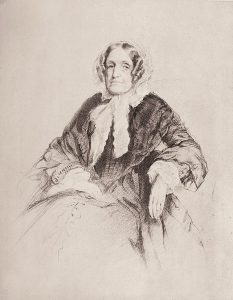
Jane Marcet, author of one of the most important popular works on chemistry at the beginning of the 19th century. Wikimedia.
The reference to Francesco Algarotti (1712-1764) in this fragment of Kant is no coincidence. He was the author of one of Newton’s most famous popular informative texts: Il newtonianismo per le dame (Naples, 1737), a work divided in six dialogues between a knight and a marchioness about Newton’s experiments with the nature of light. Like many others from those centuries, it was aimed at women, one of the most important target audiences of popular informative literature. Women of the eighteenth and nineteenth centuries were not only receivers but also authors of similar texts, some of enormous success, which were read with great delight by people of both sexes. Perhaps the best known author of the early nineteenth century in the field of experimental sciences was Jane Marcet (1769-1858). She wrote one of the most popular works of chemistry of all times Conversations on chemistry. It served, among other things, to make authors like Michael Faraday interested in science.
Of course, the misogynistic criticism of authors like Kant or Whewell were not left without an answer from women. Some years before these authors wrote the texts mentioned, Emile de Chatêlet (1706-1749), one of Newton’s leading commentators in France, had claimed that she felt ‘the full weight of prejudice’ that excluded ‘women from sciences so universally’. In order to overcome these prejudices, studies on science and gender have recovered a large number of biographies of women related to science from Antiquity to the present day. The origin of the ‘prejudices’ pointed out by Emile de Chatêlet has also been researched. These types of studies have developed enormously in the last forty years and produced a great diversity of approaches and analyses, having a great impact in many areas of the history of academic science. The final bibliography offers some of the most significant works that allow us to reconstruct the diversity of approaches. In this brief section, and as an introduction to more detailed ones, these issues have been organised into three major areas: invisibility, barriers and naturalisation.
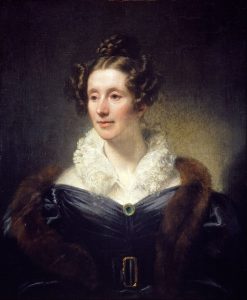
Mary Somerville, author of 19th century physics works. Wikimedia.
The first works of science and gender established the low presence of women in the historical accounts that appeared in science manuals. This was consistent with the fact that the laboratory images contained only male personnel in lab coats. An initial task was to retrieve biographies of women scientists who had been marginalised in the historical memory of the various academic disciplines. To compensate for the gaps in the general works, biographical dictionaries of women scientists were published, of which some examples are included in the final bibliography. Spaces or practices have also been recovered that, as they were mainly for women to access, had not been taken into account in historical research. An example, which has already been discussed in other sections, are the salons of the Enlightenment in the eighteenth century. More recently, women’s work in astronomical computation services has also been highlighted. As can be seen in the recent film by Theodore Melfi, Hidden Figures (2017), gender discrimination could overlap with other forms of marginalisation due to belonging to impoverished classes or racialised groups. On the other hand, the negative perception of some of the activities carried out by women, such as teaching or the dissemination of science, has also contributed to their invisibility.
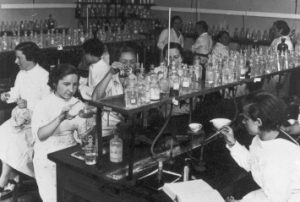
The Foster laboratory in Madrid at the beginning of the 20th century. Residencia de Estudiantes.
Another line of study on science and gender has been the analysis of the barriers limiting women’s access to scientific degrees. Nowadays, we know that many of these impediments are varied and complex, many of them invisible or naturalised by all kinds of arguments, including some from science or medicine. A large number of these impediments were formulated throughout the nineteenth century with the standards established in various educational and academic institutions that prevented women from accessing, for example, university education. These barriers remained until a good part of the twentieth century. Women were not allowed free access to higher education in Germany until 1908 or in Japan until 1913. In Spain, it was necessary to apply for various types of permits in order to study at university, until they were eliminated by a decree in 1910. The mobilisation of men during World War I left more room for women in laboratories, as Patricia Fara has shown. However, a centenary institution such as the Royal Society (established in the seventeenth century) did not admit women until 1945. To compensate for this situation, several specific spaces dedicated to the training of women in science were created in the late nineteenth and early twentieth centuries. An example are the chemistry courses started at the end of the nineteenth century in St. Petersburg, where one of the most important Russian chemists, Vera Popova (1867-1896), studied. Another example is the Forster laboratory that was installed in the student residence of Madrid at the beginning of the twentieth century.
Other types of barriers are more invisible. An example is the so-called “Matilda effect” that historian Margaret Rossiter has used to describe the different value given to the work of men and women. Women’s works are, in many cases, undervalued, and that is reflected in the distribution of honours in science, overwhelmingly controlled by men and awarded on premises that often undervalue women’s work. It is sufficient to remember that the majority of Nobel Prizes in science and medicine have been awarded to men, except for a small list of women headed by Marie Curie who won the prize in physics (1903) and chemistry (1911). Three decades later, her daughter, Irène Joliot-Curie, also won the prize in chemistry in 1935.
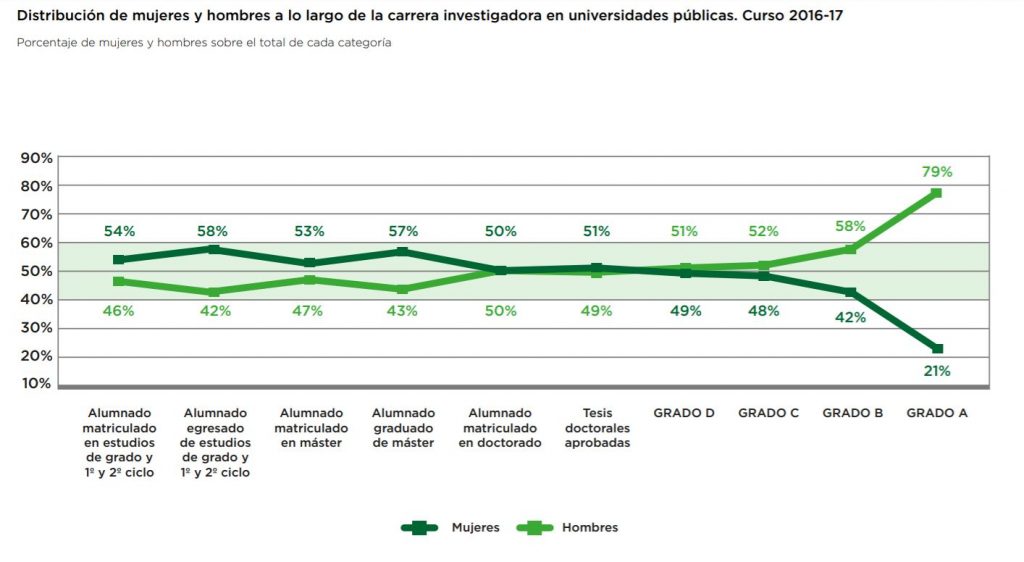
An example of the “scissors charts”, in this case referring to public higher education in Spain. One can observe the greater presence of women among the student body, reaching a percentage of 50% by the time they reach the doctorate level. Subsequent degrees clearly favour men. Científicas en cifras 2017. Ministerio de Ciencia, Innovación y Universidades.
It took another three decades for another woman, Dorothy Crowfoot Hodgkin, to gain similar recognition. The situation was similar in the field of physics (the second woman was Maria Goeppert-Mayer in 1963) and medicine (Gerty Cory, the first woman in 1947). Most of the Nobel Prizes in science and medicine given to women have been awarded in the first two decades of the twenty-first century, which may mark a change in the trend combined with years like 2019, in which no woman was awarded a prize while nine men were awarded prizes in the areas we have pointed out. This alarming data, together with stronger statistics in the form of ‘scissor charts’ or ‘glass ceilings’, confirm that these barriers persist tenaciously nowadays, despite the policies developed against them over the last decades.
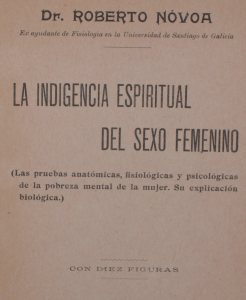
A copy of Roberto Nóvoa’s book, La indigencia espiritual del sexo femenino, which belonged to the library of the Portuguese writer Fernando Pessoa. A sample of the circulation achieved by this book. Casa Fernando Pessoa.
Medicine and science have often been used to justify these situations of discrimination. The views of authors such as Whewell or Kant in this regard have already been pointed out. Attempts to justify barriers to access certain careers through speeches based on women’s physiology or anatomy are also known. For example, shortly before the decree that opened the door to women to enter universities, a professor of pathology, Roberto Nóvoa (1885-1933), wrote a book under the significant title of La indigencia espiritual del sexo femenino (The Spiritual Poverty of the Female Sex) (Valencia, 1908). Novoa collected data from various works with which he intended to offer ‘anatomical, physiological and psychological evidence of women’s mental poverty’, of which he also offered a detailed biological explanation supposedly based on Darwinist evolutionism. The work has not withstood the passing of time, but it should not be forgotten that it was presented as an updated synthesis of the medical and scientific knowledge of its time, not as a controversial text against the massive arrival of women at universities. It is an example of many other similar speeches made from medicine or science, both in the past and today.
An anonymous author of the eighteenth century stated that “men have not only excluded women from the participation in sciences and jobs for a long time, but have also shown that this exclusion was based on the natural incapacity of women”. This third aspect, the naturalisation of gender discrimination, has been another of the main lines of research in historical studies on science and gender. Gender biases that are hidden in certain interpretations and attempts to use science to justify gender inequalities, such as Novoa’s physiological arguments, have been analysed. The predominance of masculine characters in classifications, the transfer of patriarchal roles to the natural world, the focus of medical research on male patients or the creation of particular diseases of women with the aim of keeping behaviour that was outside of the norm under control have also been pointed out. The attached bibliography provides examples of these works, so numerous and varied that it is difficult to summarise them.
These three groups of elements (invisibility, barriers and naturalisation) explain part of the conditions in which women were connected to science during the nineteenth century. And yet, there were many women who made important contributions, although few have remained in the memory of science. One of the most notable exceptions is Marie Curie, who will be mentioned again in another section, when talking about X-rays and radioactivity. Many other lesser-known women were part of the group of amateurs working in areas such as botany and astronomy. Their contribution was crucial for enabling the work of the small group of professionals who did gain fame, although they did not have the ability to undertake all the work of data collection and classification of the works mentioned. The women who worked on the periodic system, briefly described in the corresponding section, are additional examples of contributions that have been made invisible until recently.
José Ramón Bertomeu Sánchez
IILP-UV
How to cite this paper:
Bertomeu Sánchez, José Ramón. Women of science in the nineteenth century. Sabers en acció, 2021-01-08. https://sabersenaccio.iec.cat/en/women-of-science-in-the-nineteenth-century/.
Find out more
You can find further information with the bibliography and available resources.
Recommended reading
Jardins, Julie des The Madame Curie complex: the hidden history of women in science, New York, Feminist Press, 2010.
Rossiter, Margaret W. «The [Matthew] Matilda Effect in science». Social Studies of Science 23 (1993): 325-41.
Schiebinger, Londa ¿Tiene sexo la mente? València, PUV, 2004.
Studies
Abir-am , Pnina et al. eds. Creative Couples in the Sciences. New Brunswick, Rutgers University Press; 1996.
Abir-am, Pnina; Outram, Dorinda, eds. Uneasy Careers and Intimate Lives. Women in Science, 1789-1979, New Brunswick, Rutgers University Press; 1987.
Cowan, Brian. «English Coffeehouses and French Salons: Rethinking Habermas, Gender and Sociability in Early Modern French and British Historiography». In Vanhaelen,
Fara, Patricia. Pandora’s Breeches: Women, Science and Power in the Enlightenment. London: :Pimlico; 2004.
Flecha, Consuelo. Las primeras universitarias en España, 1872-1910. Narcea Ediciones, 1996.
Fox Keller, Evelyn, Reflexiones sobre género y ciencia. València, Edicions Alfons el Magnànim; 1991.
Fox Keller, Evelyn. ‘Gender and Science: Origin, History and Politics’, Osiris. 1995; 10:27-38.
García Dauder, Silvia, y Eulalia Pérez Sedeño. Las «mentiras» científicas sobre las mujeres, Madrid: Los Libros de la Catarata, 2017.
Haraway, Dona. Ciencia, cyborgs y mujeres. La reinvención de la naturaleza. València, PUV; 1995.
Jardins, Julie des. The Madame Curie complex: The Hidden History of Women in Science, New York, Feminist Press; 2010.
Jordanova, Ludmilla “Gender and the Historiography of Science’, British Journal for the History of Science. 1993; 26: 469-483.
Kohlstedt, Sally; Longino, Helen. “The Women, Gender, and Science Question: What Do Research on Women in Science and Research on Gender and Science Have to Do with Each Other?”, Osiris. 1997; 12: 3-16.
Lindee, Mary S. “The American career of Jane Marcet’s Conversations on Chemistry, 1806 –1853”. Isis. 1991; 82: 8–23.
Magallón Portolés, Carmen. Pioneras españolas en las ciencias: las mujeres del Instituto Nacional de Física y Química, Madrid: CSIC; 2004.
Neeley, Kathryn A., y Mary Somerville. Mary Somerville: science, illumination, and the female mind. Cambridge science biographies. Cambridge, UK; New York: Cambridge University Press, 2001.
Ortiz, Teresa. Medicina, Historia y Género. 130 años de investigación feminista, Granada; 2006.
Rossiter, Margaret. «The [Matthew] Matilda Effect in science». Social Studies of Science. 1993; 23: 325-41.
Rossiter, Margaret. Women scientists in America: struggles and strategies to1940. 3rd ed. Baltimore: The Johns Hopkins University Press; 1984.
Rossiter, Margaret. «Women’s work in science, 1880-1910». Isis. 1980; 71: 381-98. Schiebinger, Londa. “Cuando la ciencia era mujer”. En: Ordóñez, Javier; Elena, Alberto. (coord.) La ciencia y su público: perspectivas históricas. Madrid: CSIC; 1990.
Schiebinger, Londa. ¿Tiene sexo la mente? València, PUV; 2004.
Schiebinger, Londa (eds.). Women and Gender in Science and Technology. 4 vols. London: Routledge, 2014.
Vanhaelen, Angela; Ward, Joseph P., ed. Making Space Public in Early Modern Europe: Performance, Geography, Privacy, 41-53. London, Routledge; 2013.
Watts, Ruth. Women in Science : A Social and Cultural History, London ; New York, Routledge, 2007.
Biographical dictionaries
Alic, Margaret. El legado de Hipatia. Historia de las mujeres en la ciencia desde la Antigüedad hasta fines de siglo XIX, Madrid, Siglo veintiuno editores, 1991.
Apotheker, Jan; Simon, Livia, ed. European Women in Chemistry, VCH, Weinheim; 2011.
Grinstein, Louise S. ; Campbell, Louise S. Ed. Women of mathematics: a biobibliographic sourcebook, London; 1987.
Ogilvie, Marilyn, ed. Women in science: antiquity through the nineteenth century: a biographical dictionary with annotated bibliography, New York; 1988.
Ogilvie, Marilyn; Harvey, Joy, ed. The Biographical dictionary of women in science: pioneering lives from ancient times to the mid-20 th century, New York and London: Routledge; 2000.
Solsona i Pairó, Nuria. Mujeres científicas de todos los tiempos, Madrid, Talasa; 1997.
Sources
Jane Marcet, Conversations on chemistry, London, 1817. Available here.
William Whewell, “On the Connexion of the Physical Sciences. By Mrs. Somerville”. Quarterly Review vol. 51, March 1834, pp. 54-68.
Websites and other resources
La Bonne, eds. “Wikidones”. [Accessed 2 January 2020]. Available here.
Leon Rocha, “Gender and science: an introductory bibliography”. [Accessed 20 January 2020]. Available here.
Londa Schiebinger, Doctora Honoris Causa of the University de Valencia. Speech, 12 March 2018. Available here.
Science History Institute: Women in Chemistry. [Accessed January 2, 2020]. Available here.
Women Caucus – History of Science Society. [Accessed July 12, 2020] Available at here.



